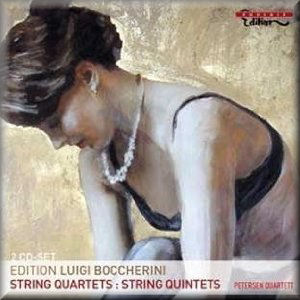 |
 |
|


alternatively
CD: MDT
AmazonUK
AmazonUS
|
Luigi BOCCHERINI (1743 -
1805)
CD 1 [61:41]
String quartet no. 90 in F major, op. 64 no. 1, G 248 (1804) [18:52]
String quartet no. 19 in D major, op. 15 no. 1, G 177 (1772) [8:10]
String quartet no. 36 in G minor, op. 24 no. 6, G 194 (1776-1778)
[14:57]
String quartet no. 55 in A major, op. 39, G 213 (1787) [19:42]
CD 2 [70:41]
String quintet no. 15 in A major, op. 60 no. 3, G 393 [16:39]
String quintet no. 23 in D major, op. 62 no. 5, G401 [17:16]
String quintet no. 62 in D major, op. 31 mo. 2, G 326 [17:23]
String quintet no. 16 in D minor, op. 13 no. 4, G 280 [19:23]
 Petersen Quartet, Ulrich Kno"rzer (viola), Guido Schiefen (cello)
Petersen Quartet, Ulrich Kno"rzer (viola), Guido Schiefen (cello)
rec. November-December 1991 (quartets), December 1992 (quintets),
SFB, Saal III, Berlin. DDD
 PHOENIX EDITION PE463 [61:41 + 70:41]
PHOENIX EDITION PE463 [61:41 + 70:41]
|
|
|
Joseph Haydn is usually regarded as the father of the string
quartet. However, Luigi Boccherini wrote his first string quartets
in 1761, just predating Haydn’s Op. 1 collection. Boccherini
could not have known Haydn’s work, so it would appear that the
two composers independently arrived at the same idea. But there
can be little doubt that Boccherini was the first to add either
a second viola or cello to the standard string quartet to form
a string quintet. This double CD with the Petersen Quartet features
four each of Boccherini’s string quartets and quintets, making
this set a convenient introduction to his chamber music.
Boccherini is a composer who is capable of surprising even when
his work seems to be proceeding along a well-trodden path. One
of the leading cellists of his day, his virtuoso command of
the instrument can be seen in his occasionally very high-lying
cello lines. Boccherini’s part-writing is correspondingly less
violin-dominated than the early Haydn quartets, all the lines
behaving with a great deal of freedom. An example is the first
movement of the Quartet no. 36, in which the theme is given
a two-part treatment featuring canonic imitation over a pedal
point. The violin and cello are often given mini-cadenzas, particularly
in the slow movements. Boccherini’s dramatic pauses also recall
Haydn, but the flightiness of his music more resembles C.P.E.
Bach.
Boccherini’s minuets are often the most interesting movements;
that of the Quintet no. 15 is a case in point. The movement
opens in a placid mood, sounding rather like a moderate tempo
scherzo. There is then an abrupt plunge into a trio featuring
a delicate violin melody over pizzicato accompaniment. The slow
movements sometimes feel like an aria for either the leader
or cello, often in a mood of tender lamentation; the second
movement of the Quintet no. 62 is a particularly fine example.
The Quintets have a noticeably richer sound, especially no.
16 with its second cello part; the opening of this work, in
which the cello shares the first subject with the leader, is
especially fine.
Many of the chamber groups that have recorded Boccherini have
done so on original instruments; the Esterhazy Quartet and Europa
Galante are two that come to mind. Because the Petersen Quartet
- and their guest second viola and cello - play on modern instruments,
their sound does not quite have the warmth of these ensembles.
Nonetheless the Petersens play with a lightness of touch that
shows how well they have thought this music through. Their performances
are elegant and sensitive, and all the players get and take
their chance to shine; I particularly enjoyed the contributions
of their cellist Hans-Jakob Eschenburg. The ensemble’s intonation
is impeccable throughout, and the recording has presence without
being too close. This set offers very fine quartet and quintet
playing, and will please anyone seeking an overview of Boccherini’s
chamber music.
Guy Aron
|
|

